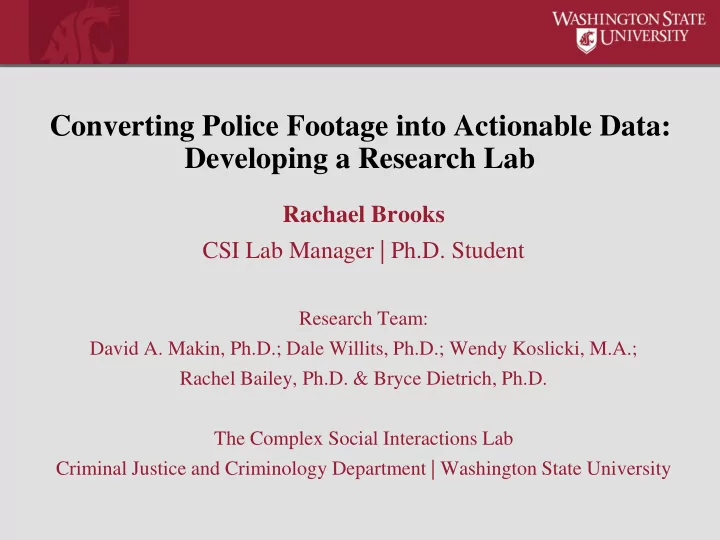

Converting Police Footage into Actionable Data: Developing a Research Lab Rachael Brooks CSI Lab Manager | Ph.D. Student Research Team: David A. Makin, Ph.D.; Dale Willits, Ph.D.; Wendy Koslicki, M.A.; Rachel Bailey, Ph.D. & Bryce Dietrich, Ph.D. The Complex Social Interactions Lab Criminal Justice and Criminology Department | Washington State University
Outline of Development Stages 1. Initial Development Stage WSU’s Criminal Interdisciplinary & The Need for a Grand Challenge Seed Justice & Criminology Intercollegiate Research Lab Grant Department Research Team 2. Gaining Data Access Multiple Stakeholder Legal, Institutional, & Justified Use of Unredacted Involvement in Approval Organizational Challenges BWC Footage Process 3. Securing and Managing Data Security & Confidentiality Infrastructure to Manage Data Annotation Software System Protocols 4. Using BWC Footage as Data Provisional Patent for Technology Automating Practical Benefits to Police Agencies and Policing BWC Analysis Research
Initial Development Stage WSU’s Criminal Interdisciplinary The Need for a Grand Challenge Justice and & Intercollegiate Criminology Research Lab Seed Grant Research Team Department • Why Develop a Research Lab Analyzing BWC Footage? – Limitations of previous research: field observations; incident reports – Agencies lack the resources to review the many hours of BWC footage recorded • Mission – The Complex Social Interactions (CSI) Lab is committed to developing new behavioral science methodologies and technologies that can be utilized in real world applications to investigate police officer decision- making and interpersonal interaction by examining unredacted footage recorded by officer body-worn cameras.
Stage 2: Gaining Data Access Legal, Institutional, & Justified Use of Unredacted Multiple Stakeholder Organizational Challenges Involvement in Approval Process BWC Footage • Sensitive Nature of Data – Development of technology only possible with unredacted footage • City Attorney and City Manager • Office of Research and Support Operations • Office of Research Assurance – Institutional Review Board – Full Board Review • Police Agency – Chief of Police; Police Guild – Memorandum of Understanding and Data Use Agreements • Data access contingent on implementing specific security protocols
Stage 3: Managing Data Infrastructure to Manage Annotation Software Security & Data System Confidentiality Protocols • Securing Data Access – Web-based cloud storage system • Two-stage identification process; frequent audits of system access; restricted IP access; firewall system; locked private lab space; computers password protected. • Securing Data Confidentiality – Data anonymized – Inclusion criteria protocol: interactions occurring in public space • Excludes: Hospitals, residence, agency, and victim statements/interviews • Annotators prohibited to annotate videos in which they know the individual – Research team and annotator requirements • The Collaborative Institutional Training Initiative (CITI) • Confidentiality Agreements • Background Security Clearance
Stage 3: Managing Data Infrastructure to Manage Annotation Software Security & Confidentiality Protocols Data System • Research Plan – Milestones and funding looking two years out • Lab Space – Furniture; locked – Technology • IT support; high-speed internet; access to a computing cluster for processing – Equipment: c omputers; noise canceling headphones • Lab Personnel – Research assistant for managing the lab; annotators • Protocol for Annotating Footage
Annotation Software System Development Training on Tier 1 Does Event Occur? Annotation Software Time of Event Videos Screened by Annotator Pair Lab Manager Verification Tier 1 Verification Videos Assigned to Pairs Tier 2 of Annotators Duration of Events Contextual Information Tier 3 of Events Changes Associated with Events Tier 2 and 3 Consensus Verification
Annotation Software System Development Software Allows one to Training on One-Hour Trainings in Flag a Video if Questions Annotation Software Groups of Four Arise Trained on Identifying All Opportunities to Practice Events that Could Occur & Discuss as a Group Inclusion Criteria: Excludes: Hospitals, Videos Screened by Interactions Occurring in Residence, Prisoner Lab Manager Transport, and Agency Public Space Two Annotators Videos Assigned to Pairs Independently Annotate Initiates Tier 1 Annotating of Annotators Same Videos • For 20 annotators, the time commitment needed of a lab manager is 65 hours a month for four months. – Trainings; Screening videos; Assigning videos; Office hours
Annotation Software System Development Tier 1 Does Event Occur? Time of Event Annotator Pair Verification Tier 1 Verification Tier 2 Duration of Events Contextual Information Tier 3 of Events Changes Associated with Events Tier 2 and 3 Consensus Verification
Example of Annotating Structure • Tier 1 – Was the Suspect Searched? If Yes, Time of Search (MM:SS). Yes (5:21) – Were Additional Officers Present? If Yes, Time of Additional Officer Arrival (MM:SS). Yes (1:12) – Were Bystanders Present? If Yes, Time when Bystander(s) are Present. No • Tier 2 – Verify Tier 1 Information (Time of Search, Time of Additional Officer Arrival, No Bystanders Present) – Was anything found during Suspect Search? If Yes, Write in Object(s). No – Was there Interaction with the Bystander? Did the Bystander use Profanity? Did the Bystander Leave? N/A ..............................................................................................................................................
Stage 4: Using BWC Footage as Data Provisional Patent for Technology Practical Benefits to Police Agencies and Automating BWC Analysis Policing Research • Improved understanding of how policing occurs in practice – Accounting for contextual, situational and dynamic factors • Allows police agencies to efficiently review their BWC footage – Risk management tool • Assess adherence to policy and protocol • Evaluate use of force beyond if it happened – Cost-Benefit Analysis • Evaluate impact of training and interventions...................................................
Contact Information Rachael Brooks Lab Manager, Complex Social Interactions Lab Ph.D. Student and Research Assistant, Department of Criminal Justice and Criminology | Washington State University rachael.brooks@wsu.edu David A. Makin, Ph.D. Principal Investigator, Complex Social Interactions Lab Assistant Professor, Department of Criminal Justice and Criminology | Washington State University dmakin@wsu.edu Complex Social Interactions Lab Website labs.wsu.edu/csi/
Recommend
More recommend